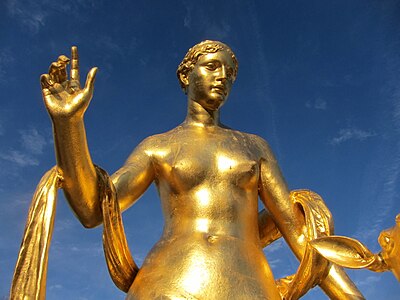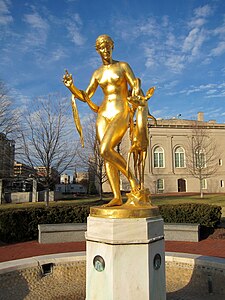
Judiciary Square is a neighborhood in the northwest quadrant of Washington, D.C., the vast majority of which is occupied by various federal and municipal courthouses and office buildings. Judiciary Square is located roughly between Pennsylvania Avenue to the south, H Street to the north, 6th Street to the west, and 3rd Street to the east. The center of the neighborhood is an actual plaza named Judiciary Square. The Square itself is bounded by 4th Street to the east, 5th Street to the west, D Street and Indiana Avenue to the south, and F Street to the north. The neighborhood is served by the Judiciary Square station on the Red Line of the Washington Metro, in addition to Washington Metropolitan Area Transit Authority bus stops.

Meridian Hill Park is an urban park in Washington, D.C., located in the Meridian Hill neighborhood that straddles the border between Adams Morgan and Columbia Heights, in Northwest D.C. The park was built between 1912-40 and covers 12-acre (49,000 m2). Meridian Hill Park is bordered by 15th, 16th, W, and Euclid streets NW, and sits on a prominent hill 1.5 miles (2.4 km) directly north of the White House. Since 1969, the name Malcolm X Park is used by some in honor of Malcolm X.
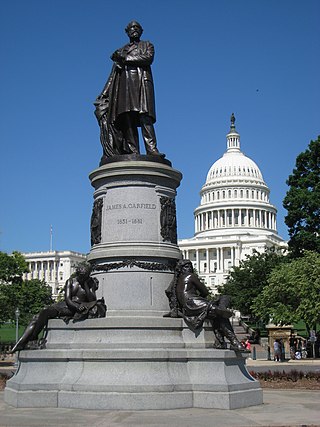
The James A. Garfield Monument stands on the grounds of the United States Capitol in Garfield Circle, a traffic circle at First Street and Maryland Avenue SW in Washington, D.C. It is a memorial to U.S. President James A. Garfield, who was elected in 1880 and assassinated in 1881 after serving only four months of his term. The perpetrator was an attorney and disgruntled office-seeker named Charles J. Guiteau. Garfield lived for several weeks after the shooting, but eventually succumbed to his injuries. The monument is part of a three-part sculptural group near the Capitol Reflecting Pool, including the Peace Monument and the Ulysses S. Grant Memorial in Union Square. The monument is also a contributing property to the National Mall and L'Enfant Plan, both of which are listed on the National Register of Historic Places and the District of Columbia Inventory of Historic Sites. The bronze statue rests on a granite pedestal that features three sculptures, each one representing a time period in Garfield's life.

The Peace Monument, also known as the Navy Monument, Naval Monument or Navy-Peace Monument, stands on the western edge of the United States Capitol Complex in Washington, D.C. It is in the middle of Peace Circle, where First Street and Pennsylvania Avenue NW intersect. The surrounding area is Union Square, which the monument shares with the Ulysses S. Grant Memorial, James A. Garfield Monument, and the Capitol Reflecting Pool. The front of the monument faces west towards the National Mall while the east side faces the United States Capitol.

The TitanicMemorial is a granite statue in the Southwest Waterfront neighborhood of Washington, D.C., that honors the men who gave their lives so that women and children might be saved during the sinking of the Titanic. Ten days after the sinking on April 25, 1912, a group of women formed a committee to raise money for a memorial to honor the sacrifice, with a limit of $1 per person. After sending thousands of cards to other women throughout the U.S., the funds the committee had raised alongside funding from the federal government was enough to complete the project. A competition was announced for a memorial design and several were submitted. The winning design by Gertrude Vanderbilt Whitney, who later opened the Whitney Museum of American Art, became her first major commission.
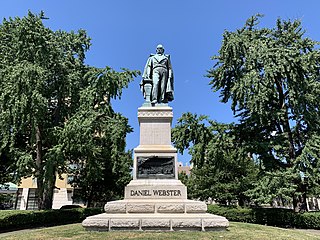
The Daniel Webster Memorial is a monument in Washington, D.C., honoring U.S. statesman and lawyer Daniel Webster. It is located near Webster's former house, beside Scott Circle, at the intersection of Massachusetts Avenue, N Street, and Rhode Island Avenue NW. The person who commissioned the memorial was Stilson Hutchins, founder of The Washington Post, who greatly admired Webster. Congress approved the memorial in 1898 and the dedication ceremony took place in January 1900. Amongst the attendees at the ceremony were President William McKinley and his cabinet, members of Congress, and Supreme Court justices.

The Luther Monument is a public artwork located in front of Luther Place Memorial Church in Washington, D.C., United States. The monument to Martin Luther, the theologian and Protestant Reformer, is a bronze, full-length portrait. It is a copy of the statue created by Ernst Friedrich August Rietschel as part of the 1868 Luther Monument in Worms, Germany. The version in Washington, D.C., inspired the installation of many other castings across the U.S. The statue is a contributing property to the Luther Place Memorial Church's listing on the National Register of Historic Places (NRHP) and District of Columbia Inventory of Historic Sites (DCIHS). It is also a contributing property to the Greater Fourteenth Street Historic District, which is also listed on the NRHP and DCIHS.

Lieutenant General George Washington is an 1860 equestrian statue of George Washington, at Washington Circle, at the edge of the George Washington University's campus, in Washington, D.C. The statue was sculpted by Clark Mills, who also created the equestrian statue of Andrew Jackson in front of the White House. The traffic circle where the statue is located was one of the original city designs by Pierre Charles L'Enfant. The statue and surrounding park are in the Foggy Bottom neighborhood at the intersection of 23rd Street, New Hampshire Avenue, and Pennsylvania Avenue NW. The K Street NW underpass runs beneath the circle.

Major General George Henry Thomas, also known as the Thomas Circle Monument, is an equestrian sculpture in Washington, D.C. that honors Civil War general George Henry Thomas. The monument is located in the center of Thomas Circle, on the border of the downtown and Logan Circle neighborhoods. It was sculpted by John Quincy Adams Ward, best known for his work on the statue of George Washington in Wall Street, Manhattan. Attendees at the dedication in 1879 included President Rutherford B. Hayes, Generals Irvin McDowell, Philip Sheridan, and William Tecumseh Sherman, senators and thousands of soldiers.

The Dupont Circle Fountain, formally known as the Rear Admiral Samuel Francis Dupont Memorial Fountain, is a fountain located in the center of Dupont Circle in Washington, D.C. It honors Rear Admiral Samuel Francis Du Pont, a prominent American naval officer and member of the Du Pont family. The fountain replaced a statue of Du Pont that was installed in 1884. Designed by Henry Bacon and sculpted by Daniel Chester French, the fountain was dedicated in 1921. Prominent guests at the dedication ceremony included First Lady Florence Harding, Secretary of War John W. Weeks and Secretary of the Navy Edwin Denby.

Brigadier General Thaddeus Kościuszko is a bronze statue honoring Polish military figure and engineer Tadeusz Kościuszko. The sculpture was dedicated in 1910, the third of four statues in Lafayette Square, Washington, D.C., to honor foreign-born heroes of the American Revolutionary War. Born in the Polish–Lithuanian Commonwealth in 1746, Kościuszko later received education at a Jesuit school before attending the Corps of Cadets in Warsaw. He later traveled to France where he studied in military academy libraries and adopted views of human liberty during the Age of Enlightenment. He moved to the Thirteen Colonies in 1776, where the war with the Kingdom of Great Britain had already begun. Kościuszko served as an engineer in the Continental Army, earning the praise of his superiors, including General George Washington.

The Court of Neptune Fountain is a fountain adorned with bronze sculptures made by Roland Hinton Perry and Albert Weinert in the late 1890s. Jerome Connor may have assisted in their manufacture. The architects for the project, which was completed in 1898, included John L. Smithmeyer, Paul J. Pelz, and Edward Pearce Casey, while the founding was completed by the Henry-Bonnard Bronze Company. The fountain is located on the west side of the Thomas Jefferson Building, the main building for the Library of Congress in Washington, D.C. The project took three years to complete.
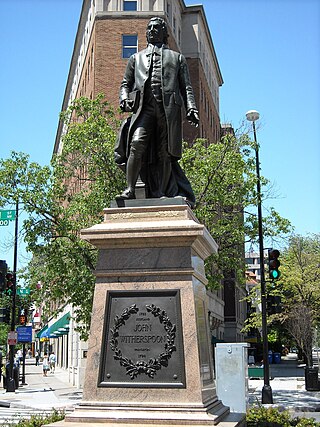
Doctor John Witherspoon is a bronze sculpture and granite pedestal which depicts John Witherspoon, a Presbyterian minister, member of Congress, and signer of the Declaration of Independence. Born in Scotland, Witherspoon immigrated to the U.S. in the 1760s and later became president of the College of New Jersey. He strongly supported the Thirteen Colonies in their fight to obtain freedom from the United Kingdom of Great Britain and Ireland.

The statue of John Barry commemorates the "Father of the United States Navy", Commodore John Barry (1745-1806). Barry was an Irish-born sailor who joined the American colonists in fighting for independence from the Kingdom of Great Britain. Barry became the first commission by the Second Continental Congress. He captained several ships during the American Revolutionary War, and not only fought in the Continental Navy, but also the Continental Army. He was the first American to capture an enemy ship and was promoted to commodore by President George Washington in 1794. Barry's last ship, the United States, fought in the Quasi-War. He retired in 1801, but remained head of the United States Navy until his death in 1806.

Major General Nathanael Greene is a bronze equestrian statue honoring Nathanael Greene, a military leader during the American Revolutionary War. Greene was from modern-day Rhode Island and after laws passed by the Kingdom of Great Britain, along with the burning of one of his ships, Greene formed a state militia. He was later promoted to brigadier general in the Continental Army where he became a trusted adviser to Commander-in-Chief General George Washington. Greene played an active role during the war, participating in battles, sieges, and campaigns from New England to the Southern Colonies. For his service to the war, Greene was offered free land and settled in Georgia with his family. He died a few years later from a heatstroke.
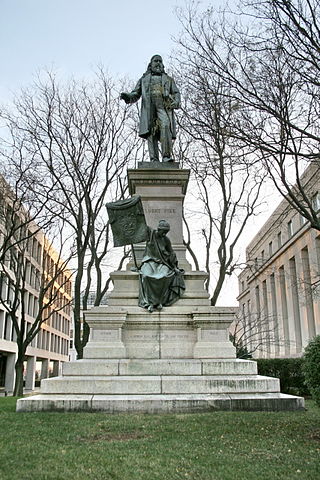
The Albert Pike Memorial is a public artwork in Washington, D.C., erected in 1901, and partially demolished in 2020 by protestors responding to the murder of George Floyd. It honors Albert Pike (1809–1891), a senior officer of the Confederate States Army as well as a poet, lawyer, and influential figure in the Scottish Rite of freemasonry. The memorial—which now only includes the base and Goddess of Masonry sculpture—sits near the corner of 3rd and D Streets NW in the Judiciary Square neighborhood. The memorial's two bronze figures were sculpted by Gaetano Trentanove, the Italian-American sculptor of another Washington, D.C., sculptural landmark, the Daniel Webster Memorial. The dedication ceremony in 1901 was attended by thousands of Masons who marched in a celebratory parade.

The James Buchanan Memorial is a bronze, granite, and concrete memorial in the southeast corner of Meridian Hill Park, Washington, D.C., that honors U.S. President James Buchanan. It was designed by architect William Gorden Beecher, and sculpted by Maryland artist Hans Schuler. The memorial was commissioned in 1916, but not approved by the U.S. Congress until 1918. The memorial features a statue of Buchanan bookended by male and female classical figures representing law and diplomacy, engraved with text from a member of Buchanan's cabinet, Jeremiah S. Black: "The incorruptible statesman whose walk was upon the mountain ranges of the law."
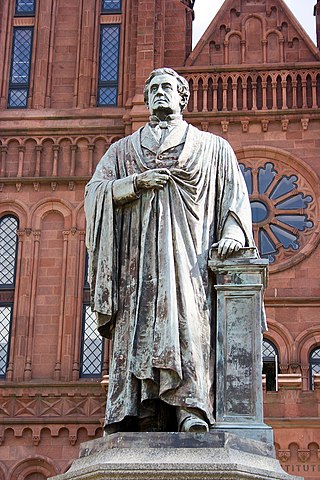
Professor Joseph Henry, also known as the Joseph Henry Memorial, is an outdoor bronze sculpture depicting scientist Joseph Henry, the first president of the Smithsonian Institution. The statue stands in front of the Smithsonian Institution Building in Washington, D.C., facing the National Mall. It was sculpted by artist William Wetmore Story, and dedicated in 1883, a few years after Henry's death. The bronze statue and granite base were unveiled in front of thousands of onlookers and invited guests. Speeches at the dedication included one from Chief Justice of the Supreme Court Morrison Waite, and the president of Yale College, Noah Porter.

Abraham Lincoln is a marble sculpture of U.S. President Abraham Lincoln by Irish artist Lot Flannery, located in front of the old District of Columbia City Hall in Washington, D.C., United States. The statue is the nation's oldest extant memorial to the president and was installed several blocks from Ford's Theatre, where Lincoln was assassinated. Flannery was present at the theater on the night of Lincoln's assassination.

The Noyes Armillary Sphere is a bronze armillary sphere located in Meridian Hill Park, a 12-acre (4.9 ha) urban park in Washington, D.C. It was the fifth artwork installed in the park and was designed by sculptor C. Paul Jennewein, whose other works in the city include the Darlington Memorial Fountain and 57 sculptural elements at the Robert F. Kennedy Department of Justice Building. Artist Bertha Noyes donated $15,000 toward the project's cost in honor of her deceased sister, Edith. The sphere is sited in the park's exedra, south of the Cascading Waterfall and reflecting pool. It rests on a granite pedestal designed by Horace Peaslee, an architect who oversaw construction of Meridian Hill Park.




